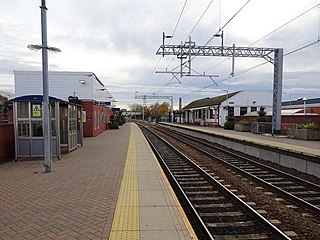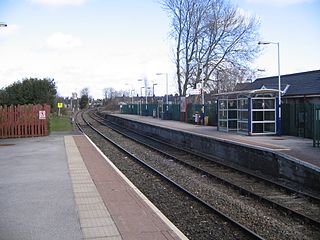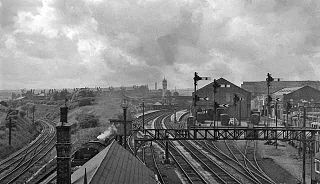Related Research Articles

Liverpool Exchange railway station was a railway station located in the city centre of Liverpool, England. Of the four terminal stations in Liverpool's city centre, Exchange station was the only station not accessed via a tunnel.
The North Union Railway was an early British railway company, operating two main routes, from Parkside to Preston and from Bolton Trinity Street to Preston, all in Lancashire. The northerly part of the routes sharing the line from Euxton to Preston.

Chorley railway station serves the town of Chorley in Lancashire, England. Since 2004 it has been linked with Chorley Interchange bus and coach station. It is on the Manchester–Preston line.

Cherry Tree railway station serves Cherry Tree in the Blackburn with Darwen borough of Lancashire, England. The station is 1.9 miles (3 km) southwest of Blackburn railway station. It is managed by Northern, who also provide all the passenger services calling there.

Adlington railway station serves the village of Adlington, near Chorley in Lancashire, England. It is a two-platform station on the Bolton - Chorley - Preston line. This is part of the Northern service link between Preston and Manchester via Bolton and Chorley.

Clitheroe railway station serves the town of Clitheroe in Lancashire, England. The station is the northern terminus of the Ribble Valley Line / Clitheroe Line operated by Northern Trains and is 10 miles (16 km) north of Blackburn. The station forms part of Clitheroe Interchange, which has won a number of awards.

Bury Knowsley Street is a former railway station in Bury.
The Preston and Longridge Railway (P&LR) was a branch line in Lancashire, England. Originally designed to carry quarried stone in horse-drawn wagons, it became part of an ambitious plan to link the Lancashire coast to the heart of Yorkshire. The ambition was never achieved, but the line continued to carry passengers until 1930 and goods until 1967.
Feniscowles railway station was a railway station that served the village of Feniscowles, in Blackburn with Darwen in Lancashire, England.

Withnell railway station was a railway station that served Abbey Village and Withnell, in Lancashire, England.

Brinscall railway station was a railway station that served the village of Brinscall, Lancashire, England.

The Lancashire Union Railway ran between Blackburn and St Helens in Lancashire, England. It was built primarily to carry goods between Blackburn and Garston Dock on the River Mersey, and also to serve collieries in the Wigan area. Most of the line has now been closed, except for the St Helens-to-Wigan section that forms part of the main line between Liverpool and the North.
Heapey railway station served the village of Heapey, in Lancashire, England.

The Manchester and Bolton Railway was a railway in the historic county of Lancashire, England, connecting Salford to Bolton. It was built by the proprietors of the Manchester, Bolton and Bury Canal Navigation and Railway Company who had in 1831 converted from a canal company. The 10-mile (16 km) long railway was originally to have built upon most of the line of the canal, but it was eventually built alongside the Salford and Bolton arms of the canal. The Act of Parliament also allowed the construction of a connection to Bury, but technical constraints meant that it was never built.

Dixon Fold railway station was built on the Manchester and Bolton Railway, between Clifton Junction railway station and Kearsley railway station, in Clifton near Pendlebury. It opened in 1841. Maps of the area from 1848 give it the name Clifton Station, which should not be confused with the nearby Clifton railway station on Rake Lane, which opened in 1847. The station closed between 2 August 1926 and 7 March 1927, but was closed permanently on 18 May 1931. The station was demolished after closure.
The Bolton and Preston Railway (B&PR) connected Bolton and Preston, in Lancashire, England. Its authorising Act of Parliament forbade its early completion to protect the North Union Railway (NUR) and imposed other restrictions that limited the success of the B&PR. A change of route was authorised to bypass the delay making it dependent on the goodwill of the NUR to reach Preston. The NUR saw the B&PR as a competitor and used underhand tactics to harm the success of the B&PR.
The Doe Lea branch is a mothballed railway line in Derbyshire, England. It connected the Derbyshire towns of Chesterfield, Staveley and Bolsover to the Nottinghamshire town of Mansfield. It also had a branch line to Creswell via the Derbyshire town of Clowne.
Allhallows Colliery railway station was in the former county of Cumberland, now Cumbria, England. It was a stop on the Bolton Loop of the Maryport and Carlisle Railway.
John Hargreaves JP was an English carrier, railway entrepreneur and manufacturing businessman. John and his father, also called John Hargreaves, were carriers in the north west of England at the time when railways were being built and taking business away from the canals.
Euxton was an early railway station serving Euxton in Chorley, Lancashire, England.
References
- ↑ Quick, M. E. (2002). Railway passenger stations in England, Scotland and Wales – a chronology. Richmond: Railway and Canal Historical Society. p. 359. OCLC 931112387.
- ↑ Butt, R. V. J. (October 1995). The Directory of Railway Stations: details every public and private passenger station, halt, platform and stopping place, past and present (1st ed.). Sparkford: Patrick Stephens Ltd. p. 195. ISBN 978-1-85260-508-7. OCLC 60251199. OL 11956311M.
53°37′20″N2°36′35″W / 53.6221°N 2.6096°W